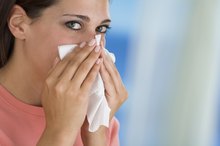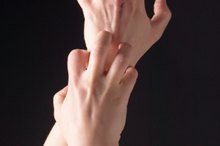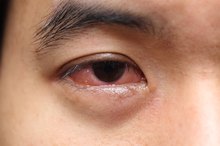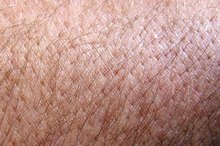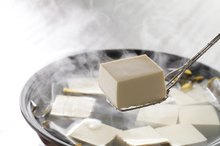Allergy & Itchy Hands and Feet
Allergic reactions occur when you encounter substances that your body mistakenly perceives as threats. Exposure to allergens may occur through skin contact, inhalation, ingestion or injection. Some allergies may cause sneezing or abdominal cramps, while others can lead to itching of your hands and feet. Identifying and eliminating the allergen can help minimize the risk of further attacks.
If you are experiencing serious medical symptoms, seek emergency treatment immediately.
Dermatitis
Dermatitis refers to skin conditions that involve inflammation and irritation. Contact dermatitis occurs from direct contact with specific substances 1. This common type of allergy may cause itching in the affected areas. Substances that frequently cause contact dermatitis in susceptible individuals include metals, cosmetics, detergents, fabrics, rubber, latex, adhesives, solvents and poisonous plants, such as:
- poison sumac
- poison ivy 1
Some airborne allergens, such as insecticides and ragweed, may lead to an allergic reaction that affects your skin.
- Dermatitis refers to skin conditions that involve inflammation and irritation.
- Contact dermatitis occurs from direct contact with specific substances 1.
Angioedema
Allergies & Redness in the Face
Learn More
Angioedema is the medical term for one type of skin disorder caused by an allergy 2. Angioedema causes welts that may feel itchy and painful 2. Although this allergic reaction frequently causes reactions in the skin around your eyes and lips, it can also affect your hands and feet. Exposure to temperature extremes or sunlight may also lead to an outbreak of itching. Other symptoms of angioedema include abdominal cramping and difficulty breathing 2.
Dyshidrotic Eczema
Dyshidrotic eczema most frequently affects women, although men may also experience symptoms of this condition 3. The exact cause of this type of eczema is unknown, although people who have allergies are more likely to develop this condition. One of the main symptoms of dyshidrotic eczema involves the appearance of blisters along your fingers, hands and feet 3. These small blisters contain fluid and can cause intense itching. The affected skin may appear red and flakey. Scratching can make the itching worse and may lead to infection.
- Dyshidrotic eczema most frequently affects women, although men may also experience symptoms of this condition 3.
- These small blisters contain fluid and can cause intense itching.
Precautions
Can Milk Thistle Cause Skin Rashes?
Learn More
See your doctor if you have symptoms of an undiagnosed allergy. Your doctor may perform a skin test to help determine the cause of your allergic reaction. Avoid scratching your itchy hands and feet. People with skin allergies may also experience breathing difficulties that can be life-threatening. Seek immediate medical care if you have difficulty breathing or feel faint.
- See your doctor if you have symptoms of an undiagnosed allergy.
- Seek immediate medical care if you have difficulty breathing or feel faint.
Related Articles
References
- MedlinePlus: Contact Dermatitis
- Medline Plus: Angioedema
- MedlinePlus: Dyshidrotic Eczema
- Lee WJ, Lee DW, Kim CH, et al. Pompholyx with bile-coloured vesicles in a patient with jaundice: are sweat ducts involved in the development of pompholyx? J Eur Acad Dermatol Venereol. 2010 Feb;24(2):235-6. doi:10.1111/j.1468-3083.2009.03383.x
- Agner T, Aalto-Korte K, Andersen KE, et al. Classification of hand eczema. J Eur Acad Dermatol Venereol. 2015 Dec;29(12):2417-22. doi:10.1111/jdv.13308
- Gerstenblith MR, Antony AK, Junkins-Hopkins JM, Abuav R. Pompholyx and eczematous reactions associated with intravenous immunoglobulin therapy. J Am Acad Dermatol. 2012 Feb;66(2):312-6. doi:10.1016/j.jaad.2010.12.034
- Nishizawa A. Dyshidrotic Eczema and Its Relationship to Metal Allergy. Curr Probl Dermatol. 2016;51:80-5. doi:10.1159/000446785
- Wollina U. Pompholyx: a review of clinical features, differential diagnosis, and management. Am J Clin Dermatol. 2010;11(5):305-14. doi:10.2165/11533250-000000000-00000
Writer Bio
Laura Wallace Henderson, a professional freelance writer, began writing in 1989. Her articles appear online at Biz Mojo, Walden University and various other websites. She has served as the co-editor for "Kansas Women: Focus on Health." She continues to empower and encourage women everywhere by promoting health, career growth and business management skills.
